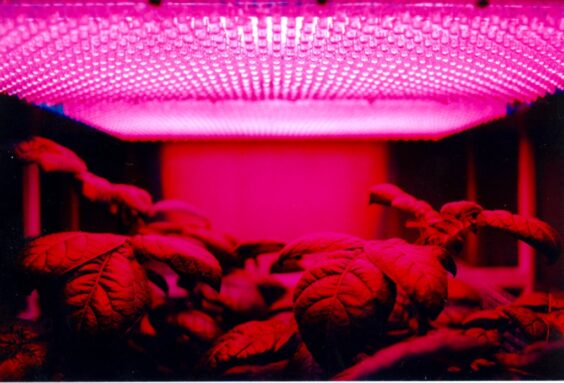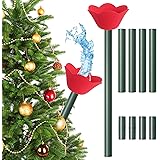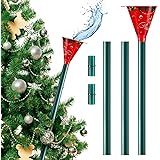Can LED light replace sunlight for plants? It’s a question that many indoor gardeners and plant enthusiasts have pondered. The answer is yes, to some extent. LED lights have come a long way in recent years, and they now offer a viable alternative to natural sunlight for plant growth. With their ability to provide specific wavelengths of light, LED lights can effectively nurture plants from seedlings to maturity.
In this article, we will explore the benefits of using LED lights for plant growth and delve into the science behind how these lights can mimic the sun’s rays. So, if you’ve been wondering about the possibility of harnessing LED light to nurture your indoor garden, you’re in the right place. Let’s dig in!
Can LED Light Replace Sunlight for Plants?
Plants rely on light as a crucial source of energy for the process of photosynthesis. The chlorophyll present in their leaves helps convert light energy into chemical energy, which is used to fuel their growth and development. Sunlight, with its full spectrum of colors, has traditionally been the primary source of light for plants.
However, advancements in technology have introduced a new player in the field – LED lights. LED, or Light Emitting Diode, lights have gained popularity in recent years as a potential alternative to sunlight for indoor gardening. In this article, we will explore the question of whether LED lights can truly replace natural sunlight in supporting plant growth.
Read More: About Do I Need a Propagator? A Gardener’s Guide
The Advantages of LED Lights for Plant Growth
LED lights offer several advantages over traditional lighting options when it comes to indoor cultivation. Here are some key benefits of using LED lights for plant growth:
- Energy Efficiency:
LED lights are incredibly energy-efficient compared to other types of lighting, such as incandescent or fluorescent bulbs. They convert a higher percentage of electricity into usable light, resulting in significant energy savings.
- Customizable Spectrum:
LED lights can be designed to emit specific wavelengths of light, allowing growers to customize the light spectrum to meet the specific needs of different plants at various stages of growth. This level of control can enhance plant productivity and overall quality.
- Reduced Heat Output:
LED lights emit very little heat compared to traditional lighting options. This is beneficial for indoor gardening as it minimizes the risk of heat damage to plants and reduces the need for additional cooling systems.
- Long Lifespan:
LED lights have an impressively long lifespan, lasting up to 10 times longer than traditional bulbs. This reduces the frequency of bulb replacements, saving both time and money.
- Compact and Flexible:
LED lights are compact and can be easily installed in tight spaces. They can also be arranged in various configurations to provide optimal coverage and intensity for different plants.
The Role of Sunlight in Plant Growth
While LED lights offer numerous advantages, it is essential to understand the unique benefits that sunlight provides to plants. Sunlight consists of a broad spectrum of light, including ultraviolet (UV) rays, visible light, and infrared (IR) radiation. Each component of sunlight contributes differently to plant growth:
- Visible Light:
Plants primarily use the visible light spectrum for photosynthesis. Different pigments in their leaves absorb specific wavelengths, with blue and red light being the most important for energy production.
- Ultraviolet (UV) Light:
Although excessive exposure to UV light can be harmful, plants benefit from a certain amount of UV radiation. UV-B light, for example, triggers specific protective mechanisms in plants, leading to the production of compounds that enhance their defense against pests and diseases.
- Infrared (IR) Radiation:
IR radiation provides heat to plants, promoting transpiration and other physiological processes. It also influences the plant’s circadian rhythm and flowering patterns.
Supplementing Sunlight with LED Lights
While LED lights can offer many advantages, outright replacing sunlight entirely may not be practical or beneficial for plant growth. However, using LED lights as a supplement to natural sunlight can provide optimal conditions for plant cultivation, especially in indoor or low-light environments. Here are some scenarios where LED lights can be particularly useful:
- Indoor Gardening:
LED lights enable indoor gardeners to create a controlled growing environment and extend the growing season. They can mimic the natural light spectrum and intensity, allowing plants to thrive in spaces with limited or no access to sunlight.
- Seed Starting:
LED lights are excellent for starting seeds indoors. They can provide the specific light wavelengths necessary for germination and early growth stages, giving seedlings a head start before they are ready to be transplanted outdoors.
- Supplementing Natural Light:
In areas with limited sunlight, such as during winter months or in shaded locations, LED lights can supplement the available natural light, ensuring plants receive sufficient light for healthy growth.
- Controlling Photoperiod:
LED lights can be used to manipulate the duration of light exposure for certain plant species. This is particularly useful for inducing or inhibiting flowering, depending on the desired outcome.
Choosing the Right LED Lights for Plant Growth
When selecting LED lights for your plants, consider the following factors:
- Light Spectrum:
Look for LED lights that offer a balanced spectrum of blue and red light, as these wavelengths are most critical for plant growth. Some manufacturers also provide full-spectrum LED lights that mimic natural sunlight more closely.
- Light Intensity:
Different plants have varying light intensity requirements. Ensure that the LED lights you choose can provide the appropriate intensity for the specific plants you are growing.
- Light Duration:
Most plants require a certain duration of light exposure each day. Ensure that the LED lights can be programmed or set up to match the plants’ natural light requirements.
- Energy Efficiency:
Opt for energy-efficient LED lights to minimize electricity consumption and reduce operational costs.
While LED lights offer numerous benefits and can be a valuable tool for indoor gardening, they cannot completely replace the benefits of natural sunlight. Sunlight provides a broad spectrum of light that plants have evolved to rely on for optimal growth and development.
However, LED lights can supplement sunlight or serve as a primary light source in environments where natural light is limited. By understanding the specific light requirements of your plants and selecting the appropriate LED lights, you can create an ideal growing environment and support healthy plant growth.
Read More: About Can You Use a Sad Light to Grow Plants?
Frequently Asked Questions (FAQs)
LED lights can be used as a supplemental light source for plants, but they cannot fully replace sunlight. Sunlight provides a full spectrum of light that is essential for plant growth, including wavelengths that LED lights may not emit.
However, LED lights can be customized to provide specific light spectra that promote plant growth, making them a popular choice for indoor gardening.
LED lights offer several advantages for plant growth:
Energy-efficient: LED lights consume less energy compared to traditional lighting sources.
Customizable light spectra: LED lights can be adjusted to emit specific wavelengths that plants need for different stages of growth.
Long lifespan: LED lights have a longer lifespan compared to other types of lighting, reducing the need for frequent replacements.
Low heat emission: LED lights produce less heat, reducing the risk of heat damage to plants.
While UV light is not essential for all plants, some plants do benefit from small amounts of UV radiation. UV light can stimulate certain physiological processes in plants, such as the production of protective compounds or the development of color and flavor in fruits and flowers.
However, excessive exposure to UV light can also be harmful to plants.
Most standard LED lights do not emit significant amounts of UV light. However, specialized LED grow lights can be designed to include UV wavelengths to provide the desired spectrum for plant growth. It’s important to choose the right LED grow light that includes UV if your plants require it.
The distance between LED lights and plants depends on the light intensity and the specific needs of the plant species.
As a general guideline, LED lights should be placed 12 to 24 inches above the plants. It’s important to monitor the plants closely and adjust the height accordingly to prevent light burn or insufficient lighting.
LED lights can be used for all stages of plant growth, from seedling to flowering and fruiting.
However, different stages of plant growth require different light spectra. LED lights can be customized and adjusted to provide the appropriate light spectrum for each stage, promoting optimal plant development.
The recommended light duration depends on the plant species and its natural light requirements. As a general guideline, most plants require around 12 to 16 hours of light per day for vegetative growth.
During flowering or fruiting stages, some plants may benefit from shorter light durations of around 8 to 12 hours. It’s important to research the specific light requirements of your plants and adjust the light duration accordingly.
Yes, LED lights are known for their energy efficiency. They consume significantly less energy compared to traditional lighting sources such as incandescent or fluorescent lights.
This energy efficiency not only saves money on electricity bills but also reduces the overall environmental impact.
Final Thoughts
LED lights have emerged as a promising alternative to sunlight for the growth of plants. Extensive research and advancements in LED technology have made it possible to create light spectra that can effectively mimic the natural sunlight. LED lights can provide plants with the necessary wavelengths for photosynthesis, promoting their growth and development. While sunlight remains the most ideal and complete light source for plants, LED lights can supplement and enhance growth in indoor settings.
By carefully selecting the appropriate LED light spectrum, intensity, and duration, it is possible to create optimal conditions for plant growth. Therefore, LED lights can indeed replace sunlight for plants, offering a viable solution for indoor gardening and farming.
Auto Amazon Links: No products found.
Perfect Plants Christmas Tree Saver 8oz. | Easy Use Xmas Tree Preserver Food | Have Healthy Green Christmas Trees All Holiday Season
$9.97 (as of December 16, 2025 05:22 GMT +00:00 - More info- Product prices and availability are accurate as of the date/time indicated and are subject to change. Any price and availability information displayed on [relevant Amazon Site(s), as applicable] at the time of purchase will apply to the purchase of this product.
FirEver Pure Christmas Tree Food | Preserver Additive & Season Extender for Live Xmas Trees | Keep It Green, Reduce Needle-Drop | Miracle Freshness (8 oz)
$14.99 (as of December 16, 2025 05:22 GMT +00:00 - More info- Product prices and availability are accurate as of the date/time indicated and are subject to change. Any price and availability information displayed on [relevant Amazon Site(s), as applicable] at the time of purchase will apply to the purchase of this product.
Rocky Mountain Goods Christmas Tree Food - 8 oz Tree Preservative - Reduce Needle Drop - Greener Scent - Fir, Pine, Spruce Trees - Extend Tree Life
$9.95 (as of December 16, 2025 05:22 GMT +00:00 - More info- Product prices and availability are accurate as of the date/time indicated and are subject to change. Any price and availability information displayed on [relevant Amazon Site(s), as applicable] at the time of purchase will apply to the purchase of this product.
EZMeetU Christmas Tree Watering Funnel, 47 Inch Flower Shape Adjustable 6 Section Design, Christmas Tree Watering System, Christmas Tree Waterer, Long Funnel Wide Opening Reusable, Plant Watering Tool
$16.99 (as of December 16, 2025 05:22 GMT +00:00 - More info- Product prices and availability are accurate as of the date/time indicated and are subject to change. Any price and availability information displayed on [relevant Amazon Site(s), as applicable] at the time of purchase will apply to the purchase of this product.
VICAMB 39.3 Inch Christmas Tree Watering Funnel,Christmas Tree Watering System Device,Long Tree Watering Funnel Spout for Indoor Outdoor Xmas Tree
$17.99 (as of December 16, 2025 05:22 GMT +00:00 - More info- Product prices and availability are accurate as of the date/time indicated and are subject to change. Any price and availability information displayed on [relevant Amazon Site(s), as applicable] at the time of purchase will apply to the purchase of this product.
Snow Joe Premium Enviro Blend Ice Melt, Green-Coated Deicer Crystals, 50 lb - Safer Melter for Vegetation, Concrete & Metals w/ Anti-Corrosion Calcium Magnesium Acetate
$32.97 (as of December 12, 2025 19:27 GMT +00:00 - More info- Product prices and availability are accurate as of the date/time indicated and are subject to change. Any price and availability information displayed on [relevant Amazon Site(s), as applicable] at the time of purchase will apply to the purchase of this product.
Muddy Mat® Shown on TV Super Absorbent Microfiber Dog Door Mat for Muddy Paws, Non-Slip Washable Pet Rug, Quick Dry Chenille Entryway Carpet, Machine Washable Indoor Outdoor mat, Grey 30"x19"
$24.95 (as of December 12, 2025 19:27 GMT +00:00 - More info- Product prices and availability are accurate as of the date/time indicated and are subject to change. Any price and availability information displayed on [relevant Amazon Site(s), as applicable] at the time of purchase will apply to the purchase of this product.
ivtivfu Rolling Grill Basket, Removable Wooden Handle, 304 Stainless Steel, Nesting BBQ Tools, Smoker Grilling Accessories for Vegetable, Outdoor Cooking Camping, Birthday Gifts for Men Dad Husband
$25.99 (as of December 12, 2025 19:27 GMT +00:00 - More info- Product prices and availability are accurate as of the date/time indicated and are subject to change. Any price and availability information displayed on [relevant Amazon Site(s), as applicable] at the time of purchase will apply to the purchase of this product.
XXXFLOWER Plant Terrarium with Wooden Stand, Air Planter Bulb Glass Vase Metal Swivel Holder Retro Tabletop for Hydroponics Home Garden Office Decoration - 3 Bulb Vase
$18.98 (as of December 12, 2025 19:27 GMT +00:00 - More info- Product prices and availability are accurate as of the date/time indicated and are subject to change. Any price and availability information displayed on [relevant Amazon Site(s), as applicable] at the time of purchase will apply to the purchase of this product.
Zevo Flying Insect Trap Official Refill Cartridges - Fits Both Zevo Trap & MAX Indoor Fly Trap - Authentic Trap+Lock Technology to Catch Gnats, House & Fruit Flys (4 Official Refill Cartridges)
$14.97 (as of December 12, 2025 19:27 GMT +00:00 - More info- Product prices and availability are accurate as of the date/time indicated and are subject to change. Any price and availability information displayed on [relevant Amazon Site(s), as applicable] at the time of purchase will apply to the purchase of this product.











